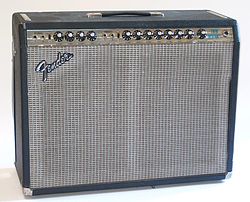In the 1935, the Laurens Hammond Organ hit the market. For the first time, anyone could have the sound of an organ in their living rooms or a smaller venue. Before this time, listeners had only been used to hearing such sounds from full pipe organs that filled large churches and concert halls. Part of the appeal of a traditonal organ was its huge sound that would bounce off the walls of cathedrals and amphitheaters to give the listener the effect that the room itself was generating the monstrous sound of a full pipe organ. With most people's homes being small, carpeted rooms with draperies and other sound-absorbing elements, what was to be replicating the large resonating sound of a pipe organ was reduced to a small, tin-sounding keyboard.
To expand the sound and give the listener the illusion of resonance, the Hammond Organ Company borrowed some sound-enhancing technology from the Bell Phone Company to enlarge the tone of their organs. The device was a series of dampening springs contained in long oil-filled tubes that controlled the decay length of the sound. By expanding the sound-decay replication device to be amplified through larger speakers, spring reverberation (or spring reverb, as its known in modern times) was born. Overtime, the long tubes were redesigned to fit into more compact spaces which expanded their application beyond the world of the organ.
Because of their compact size and uncanny ability to simulate the resonance of a larger venue from a small amplifier, Fender Electric Instrument Company decided to install the spring reverb device in some of their models of amplifiers. The most popular of these amplifiers were the Fender Twin Reverb and the Fender Super Reverb. In addition to simulating resonance and generating swelling sounds, spring verb also had a side effect of a loud thunderous crash when amplifiers were shaken, rocked, or dropped due to the internal springs colliding with the tubes and other components inside the amplifier. Once posing an ear-ache from bumped organs in smaller churches, the progression of heavier, grittier sound in rock-n-roll music actually had musicians seeking after the roaring crash from a spring reverb pushed through an overdriven speaker. Famous rock bands like The Who and others were known to purposely rattle amplifiers to awaken the booming crash of the spring reverb.
Though digital synthesizers have taken the place of many spring reverb sounds in modern music, there has been a great longing for the unique swells and ringing spring tones that modern technology hasn't been able to completely reproduce. Even for many younger musicians who were born after the invention of digital reverb, their ears have been trained to crave the organic sound of real spring reverberation from listening to recordings of some of the pioneers of rock-n-roll and rhythm-and-blues music. The raw sound of real spring reverberation will always be a crucial ingredient in the history of rock-n-roll sound.
For more on superior spring products and support, be sure to check out EBSCO Spring Company for springs that rock.



No comments:
Post a Comment